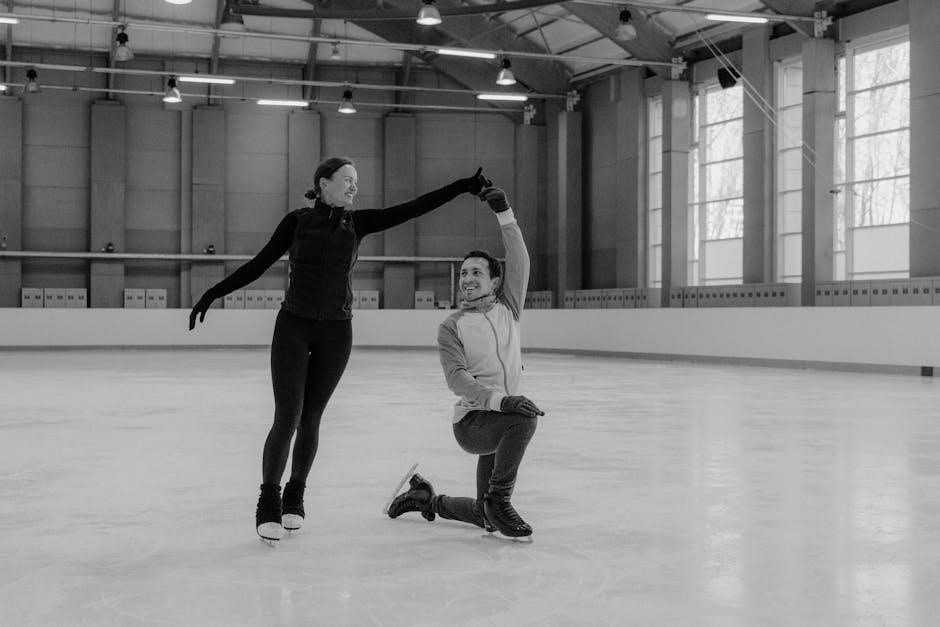Sacroiliac joint exercises are crucial for managing SI joint pain, improving joint function, and enhancing overall mobility. They include stretching, strengthening, and low-impact aerobic activities tailored to alleviate discomfort and promote stability. Consulting a healthcare professional before starting is essential to ensure safety and effectiveness.
What Are Sacroiliac Joints?
The sacroiliac (SI) joints are critical structures located between the sacrum (base of the spine) and the ilium (pelvic bone). These joints are designed to absorb shock and facilitate limited movement between the upper body and legs. The SI joints play a vital role in stabilizing the pelvis during activities like walking, sitting, and lifting. They are synovial joints, meaning they are lined with cartilage and filled with fluid to reduce friction. However, their movement is restricted by strong ligaments, making them less flexible compared to other joints. Dysfunction or inflammation in the SI joints can lead to pain and discomfort, often affecting daily activities and overall mobility.
- Location: Between the sacrum and ilium bones.
- Function: Absorb shock, stabilize the pelvis, and enable limited movement.
- Structure: Synovial joints with cartilage and ligament support.
Why Are Sacroiliac Exercises Important?
Sacroiliac exercises are essential for maintaining joint stability, relieving pain, and improving mobility. They help strengthen the muscles surrounding the SI joints, enhancing their ability to absorb shock and support the pelvis during movement. Regular exercises can reduce inflammation, restore proper joint function, and prevent further dysfunction. By addressing muscle imbalances and improving posture, these exercises contribute to long-term pain management and overall pelvic health. They are particularly beneficial for individuals with SI joint dysfunction, as they promote healing and reduce the risk of recurring discomfort. Consistent practice can significantly enhance quality of life by enabling pain-free daily activities and maintaining physical independence.
- Enhance joint stability and strength.
- Relieve pain and inflammation.
- Improve mobility and posture.
- Prevent future dysfunction.

Types of Sacroiliac Exercises
Sacroiliac exercises include stretching, strengthening, and low-impact aerobic activities. These exercises target the muscles and joints to improve stability, reduce pain, and enhance mobility. They are tailored to address specific needs and promote overall pelvic health.
Stretching Exercises for Sacroiliac Pain Relief
Stretching exercises are a fundamental approach to alleviating sacroiliac joint pain by reducing tension in the surrounding muscles and improving joint mobility. Key stretches include the knee-to-chest stretch, piriformis stretch, and figure-4 stretch. These exercises target the lower back, hips, and glutes, providing relief from stiffness and discomfort. To perform the knee-to-chest stretch, lie on your back and gently pull one knee toward your chest, holding for 20-30 seconds. The piriformis stretch involves crossing one ankle over the opposite knee and pushing the knee toward the chest. The figure-4 stretch uses a strap or band for deeper relief. Regular stretching can reduce muscle spasms and improve flexibility, making daily activities easier. Always consult a healthcare professional to ensure proper technique and safety.
Strengthening Exercises for Sacroiliac Joint Stability
Strengthening exercises are essential for improving sacroiliac joint stability and reducing pain. Key exercises include the clamshell, bridging, and side plank. The clamshell strengthens the glutes and pelvis muscles by squeezing the knees together while lying on your side. Bridging targets the core and hip muscles by lifting the hips toward the ceiling. Side planks enhance pelvic stability by holding a plank position on one side. These exercises help restore muscle balance and provide structural support to the sacroiliac joint. Consistency is crucial, and proper form should always be maintained to avoid injury. Consulting a healthcare professional ensures exercises are tailored to individual needs and promotes long-term joint health.
Low-Impact Aerobic Exercises for Sacroiliac Health
Low-impact aerobic exercises are ideal for maintaining sacroiliac health without putting excessive strain on the joint. Activities such as swimming, cycling, and brisk walking are highly recommended as they promote cardiovascular fitness while minimizing stress on the SI joint. These exercises improve blood flow, strengthen surrounding muscles, and enhance joint mobility. Swimming, in particular, is beneficial due to its weight-bearing nature, which reduces pressure on the sacroiliac joint. It’s important to avoid high-impact activities like running or jumping, which can exacerbate pain. Regular low-impact aerobics can help maintain joint stability and overall well-being. Always consult a healthcare professional to tailor exercises to your specific condition and ensure safe practice.

Best Stretching Exercises for Sacroiliac Joint Pain
Effective stretching exercises for sacroiliac joint pain include knee-to-chest stretches, piriformis stretches, and figure-4 stretches; These exercises relieve tension, improve flexibility, and promote joint mobility, offering significant pain relief and enhanced comfort.
Knee-to-Chest Stretch
The knee-to-chest stretch is a simple yet effective exercise for alleviating sacroiliac joint pain. To perform, lie on your back and bring one knee toward your chest while keeping the other leg straight. Gently hold the knee with your hand and pull it closer to your chest until you feel a mild stretch in your lower back and hip. Hold this position for 20-30 seconds, then slowly release. Repeat on the other side to ensure balanced relief. This stretch helps reduce tension in the sacroiliac joint and surrounding muscles, promoting relaxation and improved mobility. It is essential to avoid bouncing or forcing the stretch beyond a comfortable range to prevent further discomfort.
Piriformis Stretch
The piriformis stretch is a highly effective exercise for relieving sacroiliac joint pain by targeting the piriformis muscle, which runs close to the SI joint. To perform, sit on the floor with your legs extended. Cross the affected leg over the other thigh, placing the ankle on the opposite knee. Gently push the knee of the crossed leg toward your opposite shoulder using your hand until you feel a stretch in the buttock area. Hold for 20-30 seconds, then release. Repeat on the other side if needed. This stretch helps alleviate tightness in the piriformis muscle, which can contribute to SI joint discomfort. Avoid bouncing or forcing the stretch to prevent increased pain.
Figure-4 Stretch
The Figure-4 Stretch is an excellent exercise for targeting the sacroiliac joint and surrounding muscles. To perform, lie on your back and cross one leg over the other, forming a “4” shape with your legs. Place your ankle on the opposite knee, ensuring your foot flexes. Gently push the knee of the crossed leg toward your chest using your hand until you feel a stretch in the outer hip and glutes. Hold for 20-30 seconds, then release. Repeat on the other side if needed. This stretch helps relieve tension in the piriformis and gluteal muscles, which can contribute to SI joint pain. Use a strap or towel for assistance if necessary, and avoid bouncing to prevent discomfort.

Strengthening Exercises for Sacroiliac Joint Dysfunction
Strengthening exercises for sacroiliac joint dysfunction focus on improving stability and reducing pain. They target muscles around the SI joint, enhancing support and promoting proper joint function.
Clamshell Exercise
The clamshell exercise is a highly effective strengthening exercise for sacroiliac joint dysfunction. It targets the gluteal muscles, which play a crucial role in stabilizing the SI joint. To perform the clamshell, lie on your side with your knees bent and feet touching. Slowly lift the top knee upward without moving your pelvis, squeezing your glutes at the top of the movement. Hold for a few seconds, then lower your knee back down. This exercise helps improve joint stability and reduces pain by strengthening the surrounding muscles. Start with a few repetitions and gradually increase as your strength improves. Avoid any movement that causes pain, and focus on controlled, slow motions for optimal results.
Bridging Exercise
The bridging exercise is a foundational strengthening exercise for sacroiliac joint stability. It targets the gluteal muscles and lower back, which are essential for supporting the SI joint. To perform the bridge, lie on your back with your knees bent and feet flat on the floor. Slowly lift your hips toward the ceiling, squeezing your glutes at the top of the movement. Hold for a few seconds, then lower your hips back down. This exercise helps improve posture, reduce pain, and enhance joint stability. Start with 10-15 repetitions and gradually increase as your strength improves. Focus on controlled movements to avoid strain and maximize benefits for your sacroiliac joint health.
Side Plank
The side plank is an effective exercise for enhancing sacroiliac joint stability by strengthening the gluteus medius and core muscles. To perform, lie on your side with feet stacked and elbows under shoulders. Lift hips off the ground, forming a straight line from head to heels. Engage your core and hold for 20-30 seconds, then lower slowly. This exercise improves posture, reduces SI joint pain, and boosts overall lower back stability. Start with shorter holds and gradually increase duration as strength improves. Proper form is crucial to avoid strain and maximize benefits for sacroiliac health.

When to Start Sacroiliac Exercises
Start sacroiliac exercises after consulting a healthcare professional to ensure safety and effectiveness. Begin slowly, assessing pain levels to avoid exacerbating symptoms and adjusting routines as needed.
Consulting a Healthcare Professional
Consulting a healthcare professional is essential before starting sacroiliac exercises. They will assess your condition, diagnose the root cause of pain, and recommend tailored exercises. A professional can ensure exercises are safe and effective, avoiding overexertion. They may suggest physical therapy or specific routines based on your symptoms. Starting without guidance can worsen symptoms or lead to injury. A healthcare provider can also monitor progress and adjust routines as needed. This personalized approach ensures optimal results and prevents further discomfort. Always seek expert advice to create a safe and effective exercise plan for sacroiliac joint pain management.
Assessing Pain Levels Before Starting
Assessing pain levels before starting sacroiliac exercises is crucial to ensure safety and effectiveness. Evaluate the severity and location of your pain to determine appropriate exercises. Begin with gentle movements to gauge your body’s response. If pain worsens, stop immediately and consult a professional. Monitoring discomfort helps guide exercise intensity and avoid aggravation. Track progress consistently to identify improvements or setbacks. Adjust routines based on pain feedback to promote healing and stability. This approach ensures exercises are tailored to your condition, minimizing risks and maximizing benefits for sacroiliac joint health.

Safety Precautions for Sacroiliac Exercises
Always consult a healthcare professional before starting sacroiliac exercises to avoid worsening pain. Use proper form, avoid overexertion, and stop if pain increases. Listen to your body.
Avoiding Overexertion
Avoiding overexertion is critical when performing sacroiliac exercises to prevent aggravating the joint. Start with gentle movements and gradually increase intensity as comfort allows. Never push through sharp pain or discomfort, as this can worsen inflammation or instability. High-impact activities and repetitive bending or twisting should be avoided initially. Focus on controlled, low-intensity exercises that promote stability without strain. Listening to your body and stopping at the first sign of pain ensures a safe and effective routine. Overexertion can lead to setbacks, so prioritize moderation and technique to protect the sacroiliac joint during rehabilitation.
Stopping Exercises if Pain Increases
Stopping exercises if pain increases is essential to avoid further irritation or damage to the sacroiliac joint. If you experience a sharp or persistent increase in pain during or after an exercise, cease the activity immediately. Continuing despite discomfort can exacerbate inflammation or instability. Rest the area and reassess the exercise to ensure proper form and technique. If pain persists or worsens, consult a healthcare professional for guidance. Prioritizing joint health by halting exercises when pain arises helps prevent long-term complications and promotes a safer recovery process. Always listen to your body and adjust your routine accordingly to maintain progress without risking further injury.

Creating a Daily Routine for Sacroiliac Exercises
A daily routine should include consistent practice of stretching, strengthening, and low-impact aerobic exercises. Start with gentle stretches, progress to strengthening, and finish with low-impact aerobics; Set realistic goals and track progress to ensure long-term benefits and joint stability. Regular practice helps maintain mobility and reduces discomfort effectively.
How to Incorporate Exercises into Your Daily Schedule
Incorporating sacroiliac exercises into your daily routine can be straightforward with proper planning. Start by setting aside 15–20 minutes each day, ideally in the morning or before bed. Begin with gentle stretches like the knee-to-chest or piriformis stretch to loosen tight muscles. Gradually add strengthening exercises such as bridging or clamshells to improve joint stability. Low-impact aerobics like swimming or cycling can be included 2–3 times a week to enhance mobility without overexertion. Track your progress using a journal or app to stay motivated. It’s essential to consult a healthcare professional to tailor the routine to your specific needs and ensure safety. Consistency is key to achieving long-term relief and improved joint function.
Tracking Progress and Adjusting the Routine
Tracking your progress in sacroiliac exercises is essential for maximizing their effectiveness. Use a journal or mobile app to record the exercises performed, duration, and intensity. Note any changes in pain levels or joint mobility. Regularly assess whether the exercises are helping to reduce discomfort and improve function. If progress stalls or pain increases, consider adjusting the routine by modifying the exercises or consulting a healthcare professional. Gradually increase the intensity or duration as your condition improves. Adjustments should be made to ensure continued progress without overexertion. Consistent monitoring and tailored modifications will help achieve long-term relief and stability in the sacroiliac joint.
Additional Resources for Sacroiliac Exercises
Downloadable PDF guides and online videos provide detailed instructions and visual demonstrations for sacroiliac exercises, helping you follow structured routines effectively at home.
Downloading Sacroiliac Exercises PDF Guides
Downloading sacroiliac exercises PDF guides is an excellent way to access structured routines and visual instructions for managing SI joint pain. These guides typically include detailed step-by-step instructions, diagrams, and progress tracking sheets. They often cover stretching, strengthening, and low-impact aerobic exercises tailored for sacroiliac joint health. Many PDF guides are created by physical therapists or healthcare professionals, ensuring the exercises are safe and effective. You can easily print them for convenience or follow along digitally. Additionally, these guides may offer tips on proper posture, body mechanics, and modifications for different fitness levels. Downloading a sacroiliac exercises PDF is a great resource for anyone looking to take control of their SI joint pain at home.
Online Videos and Tutorials
Online videos and tutorials are an invaluable resource for learning sacroiliac joint exercises. Platforms like YouTube offer a wide range of instructional content, often led by physical therapists or fitness experts. These videos provide visual guidance, helping you master proper form and technique. Many tutorials focus on specific stretches, such as the piriformis stretch or figure-4 stretch, while others cover strengthening exercises like bridging or clamshell exercises. Additionally, some videos include routines tailored for different fitness levels, ensuring everyone can benefit. By following these tutorials, you can perform exercises confidently at home, making them a great supplement to sacroiliac exercises PDF guides. They also offer real-time demonstrations, which can be more engaging and easier to follow than written instructions alone.
Consistency is key to managing sacroiliac joint pain. Regular exercises, combined with professional guidance, can significantly improve joint stability and overall well-being. Stay committed for long-term relief.
Final Tips for Managing Sacroiliac Joint Pain
Consistency is essential for effective sacroiliac joint pain management. Always listen to your body and avoid overexertion. Incorporate a mix of stretching, strengthening, and low-impact aerobic exercises into your daily routine. Prioritize exercises like the knee-to-chest stretch, piriformis stretch, and clamshell exercise, which target the SI joint and surrounding muscles. Swimming and cycling are excellent low-impact options to maintain mobility without aggravating the joint. Maintain proper posture and avoid activities that strain the lower back. Gradually progress your routine and seek professional guidance if pain persists. Remember, patience and adherence to a well-structured plan are key to long-term relief and joint stability.
The Importance of Consistency in Exercise
Consistency is vital when performing sacroiliac joint exercises to achieve lasting relief and stability; Regular practice helps strengthen the surrounding muscles, improving joint function and reducing pain over time. Even small, daily efforts can lead to significant progress. It’s important to avoid sporadic or intense workouts, as this may worsen symptoms. Instead, focus on gradual, steady improvement. Stopping exercises if pain increases is crucial to prevent further irritation. By maintaining a consistent routine tailored to your needs, you can effectively manage SI joint pain and enhance your overall mobility. Remember, consistency is key to long-term healing and prevention of future discomfort.
